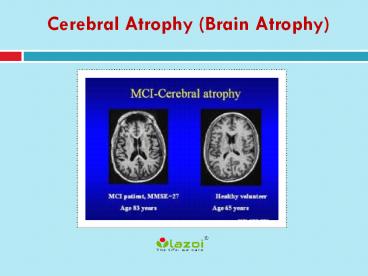Cerebral Atrophy (Brain Atrophy): Learn about symptoms, causes and treatment - PowerPoint PPT Presentation
Title:
Cerebral Atrophy (Brain Atrophy): Learn about symptoms, causes and treatment
Description:
Brain atrophy, which is also known as cerebral atrophy, is a health related condition where the nerve cells or neurons are lost and the connection between them is damaged. This cerebral atrophy affects either one or both the hemispheres of the brain. – PowerPoint PPT presentation
Number of Views:598
Title: Cerebral Atrophy (Brain Atrophy): Learn about symptoms, causes and treatment
1
Cerebral Atrophy (Brain Atrophy)
2
Cerebral Atrophy (Brain Atrophy)
- Brain atrophy, which is also known as cerebral
atrophy, is a health related condition where the
nerve cells or neurons are lost and the
connection between them is damaged. This cerebral
atrophy affects either one or both the
hemispheres of the brain. In this brain disorder,
like other atrophies, there is a considerable
amount of wastage or loss of brain tissues. This
wastage of brain cells (also called neurons),
affects the proper functioning of the brain. Loss
of neurons in the brain is a highly undesirable
condition as it results in many cognitive and
neurological problems. There are two types of
atrophy of the brain - focal atrophy and total or
generalized atrophy. In focal cerebral atrophy,
the damage of brain cells is concentrated on a
particular region of the brain. But in complete
atrophy, the damage is done to the whole brain
and this cause is associated with a myriad of
problems.
3
Cerebral Atrophy Causes
- Normally brain stem atrophy is caused due to
aging. But in some cases, the wastage of brain
cells can be triggered due to some illnesses,
which may cause premature wastage or even speed
up the process. Given below is a list of reasons
why the cells in the bodys most important organ
are lost. - Epilepsy, which is a neurological disorder that
can result in seizures. - Kearns Sayre syndrome, a disease that causes
weakness to the muscles due to mitochondrial
encephalomyopathies, which is the changes that
occur in the mitochondria of the cells. This
syndrome tends to interfere with the proper
functioning of the neurons. - A traumatic brain injury resulting in stroke.
4
Cerebral Atrophy Causes
Continue
- Some infectious diseases like neurosyphilis, AIDS
and encephalitis which can lead to the damage of
the brain cells leading to brain shrinkage by
destroying the neurons and their axons. - A condition called multiple sclerosis, where the
cerebral tissue becomes inflamed and there is
damage to the myelin (a protective cover on the
nerve fibres) due to the growth of lesions. - Cerebral palsy, where there is impairment in the
coordination of the motor neurons in the damaged
areas caused due to lesions. - Krabbe disease, where the myelin sheath that
protects the axons (also known as nerve fibres)
is destroyed. - Certain genetic disorders like Huntingtons
disease that leads to an increase in the toxic
levels of proteins in the neurons. - Other causes of atrophy are Alzheimers
disease and Picks disease.
5
Symptoms
- In some patients chronic or persistent wastage
of brain stem cells called cachexia is observed.
Brain cell atrophy is very common in people who
are suffering from AIDS. An individual who
suffers from this brain related disease will show
the following symptoms - An illness, known as dementia, where the person
suffers from a loss of memory and cognitive
skills. The inability to learn, loss of memory
and disorientation are some of the signs that an
individual is a dementia patient. - A condition related to language disorders
called aphasias, where the individual finds it
difficult to understand language. There are two
types of aphasias - expressive aphasias and
receptive aphasias.
6
Symptoms
Continue
- In expressive aphasias, the individual may often
use incomplete sentences, odd choices of words,
misspell certain words and use disjointed
clauses. Receptive aphasias leads to impaired and
improper comprehension skills. - Another symptom of cerebral atrophy is seizures,
which results in convulsions, repetitive
movements of the limbs and loss of consciousness.
7
Treatment
- In order to detect the presence of this
condition, the affected individual may have to
undergo a multi resonance imaging (MRI) scan to
check for any impairments in the brain. The
treatment depends on the age of the affected
individual and also on the type of cerebral
atrophy. If this condition is caused due to
alcoholism or drug abuse, it is advisable to
restrict the intake of alcohol and drugs
completely. The individual can also take brain
food and vitamin supplements to ensure the proper
functioning of the brain. And last but not the
least, practice a healthy lifestyle to ward off
any diseases. Though there is no certain cure
for brain cell degeneration, symptomatic
treatment can be given to the patients suffering
from this condition. Researchers have been
carried out to find a cure for this disorder and
treat it successfully.
8
CONNECT WITH US
- Logon to
- www.lazoi.com
- Like us on Facebook
- https//www.facebook.com/LazoiTheLife
- Follow us on Twitter
- https//www.twitter.com/lazoithelife
- Follow us on Pinterest
- https//www.in.pinterest.com/lazoithelife

